M. Mehade Hasan1, M. I. Ali2, D. Paul2, M. A. Haydar2, S. M. A. Islam1
1Department of Physics, Jahangirnagar University, Savar, Dhaka-1342, Bangladesh
2Health Physics and Radioactive Waste Management Unit (HPRWMU), Institute of Nuclear Science and Technology (INST), Atomic Energy Research Establishment (AERE), Bangladesh Atomic Energy Commission (BAEC), Savar, Dhaka, Bangladesh
Correspondence to: M. Mehade Hasan, Department of Physics, Jahangirnagar University, Savar, Dhaka-1342, Bangladesh.
| Email: |  |
Copyright © 2012 Scientific & Academic Publishing. All Rights Reserved.
Abstract
The activity concentrations of naturally occurring radionuclides Ra-226, Th-232 and K-40, were measured by using a gamma ray spectrometry for coal, soil and water samples collected from the Barapukuria coal mine in Dinajpur district of Bangladesh. The average activity concentrations of Ra-226, Th-232 and K-40 in coal samples were found to be 6.21±3.68, 10.69±7.5 and 185.76±138.86 Bqkg-1, respectively; and those for active soil samples were found to be 23.54±2.6, 52.10±4.73 and 603.17±66.40 Bqkg-1, respectively; and for passive soil samples were 36.75±3.38, 76.79±5.53 and 607.18±83.50 Bqkg-1, respectively. The results for both the soil samples obtained for the corresponding nuclides are slightly higher than the worldwide average values of 35, 30 and 400 Bqkg-1 respectively except that of Ra-226 for active soil samples. The activity contents of the water samples did not show any evidence of enhancement due to the mining activities. The average absorbed dose rate (D) and outdoor annual effective dose (E), were observed to be 12.05 nGyh-1 and 0.015 mSvyr-1 for coal, respectively. The values were 67.14 nGyh-1 and 0.083 mSvyr-1 respectively for active soil and 88.86 nGyh-1, and 0.11 mSvyr-1, respectively for passive soil. The average absorbed dose rates were higher than worldwide average values for soil samples. Whereas, the radium equivalent activity and external hazard indices were less than the world average values.
Keywords:
Natural Radioactivity, Activity Concentrations, Absorbed Dose Rate, Outdoor Annual Effective Dose, Radium Equivalent Activity, External Hazard
Cite this paper: M. Mehade Hasan, M. I. Ali, D. Paul, M. A. Haydar, S. M. A. Islam, Measurement of Natural Radioactivity in Coal, Soil and Water Samples Collected from Barapukuria Coal Mine in Dinajpur District of Bangladesh, Journal of Nuclear and Particle Physics, Vol. 3 No. 4, 2013, pp. 63-71. doi: 10.5923/j.jnpp.20130304.03.
1. Introduction
The applications of radiations have become part and parcel in human life. We receive radiation emitted from the floor and walls of our homes, food we eat and drink and the air we breadth. The concept of technologically enhanced natural radioactivity (TE NORM) was introduced in the mid-seventies. It represents the unintentional exposure to natural sources of radiation which would not exist without the technological activity[1]. The natural radioactivity in the environment is the main source of radiation exposure for human body. Natural radionuclide in coal, soil and water contribute a significant amount of background radiation exposure to the population through inhalation and ingestion as well as through direct external exposure.The main contributor radionuclides responsible for human exposure are Ra-226, Th-232 and K-40 and these radionuclides in the solid and liquid samples are not uniformly distributed and vary from region to region[2]. Therefore, the knowledge of their distribution in coal, soil and water play an important role in radiation protection activities and measurement[3, 4]. The radioactivity concentration of these nuclides above permissible level is very harmful to the human body. Therefore, measurement of natural radioactivity in these elements and the radiation doses arising from these radionuclides are of great interest to the researchers which have led the nationwide surveys throughout the world[5, 6]. Coal and soil contain natural radionuclides of wide range of activity levels. This radioactivity can be transported to the earth surface by several processes including: tectonic movement, volcanic activity, ore/coal mining and ground water flow. The transportation by groundwater flow and similar mechanism depends on the solubility and chemical reactions of the radioactive substance, and the porosity of the ground[7]. Bangladesh has a good amount of coal deposit in its territorial area. Especially the northern part of the country is rich in coal deposit. It has five discovered coal mines namely Barapukuria, Phulbari, Khalashpir, Jamalganj and Dighipara and all these mines are located in the northern region of the country. But only the Barapukuria coal mine is currently under production. The coal extracted from these mines is used in various purposes including power generation, burning in the brick fields and so on. Coal also contains natural radionuclides such as Ra-226, Th-232 and K-40. The coal mine workers, public and the environment may be affected due to the mining and use of coal in various purposes. Therefore, it is worthy of investigating the radionuclide contents in the coal extracted from these mines and their activity level due to these radionuclides for the safety of the workers, public and the environment. Moreover, contamination may happen in the surrounding environmental elements such as soil and water due to the leaching of radionuclides due to mining. A very little data is available on the radioactivity contents in coal, radiological impact of the coal and coal mining on people and environment of Bangladesh. Therefore, this study was designed to conduct a thorough study on the radionuclide contents and radiological implications on the coal mine workers, public and environment due to the mining and use of the coal in Bangladesh.
2. Methods and Materials
2.1. Study Area
Dinajpur is an administrative district under the Rangpur Division and is situated in the Northern part of Bangladesh. It is bounded by Thakurgaon and Panchagarh districts in the north, Gaibandha and Joypurhat districts in the south, Nilphamari and Rangpur districts in the east and the state of West Bengal, India in the west. The Barapukuria coal mine is located at Chowhati under Parbatipur police station. Figure 1 shows the map of the Dinajpur district and location of Barapukuria coal mine. | Figure 1. Location map of the coal mines in Bangladesh including the Barapukuria coal mine |
2.2. Sampling Locations
A total of 20 samples namely; 4 coal, 8 soil and 8 water samples; were collected from in and around the coal mine area. Eight soil samples were divided into two groups namely; active and passive soil samples. Moreover, among eight water samples, 4 were surface water and 4 were tube-well water. The samples were collected during the whole day on 7 May 2012. The location of Barapukuria coal mine is in between the latitude 25˚33'15" to 25˚34'15" N and longitude 88˚57' to 88˚59' E.
2.3. Sample Collection and Preparation
It was stated earlier section that 4 coal samples, 8 soil samples and 8 water samples were collected from in and around of coal mine area. Four coal samples were collected from the four sides of the coal deposit which were marked as the sample code: 1(a), 1(b), 1(c) and 1(d). Active soil samples were also collected from four sides of the coal deposit with an approximately distance of 10 meter from the deposit and were marked as 2(a), 2(b), 2(c) and 2(d). Passive soil samples were collected from approximately 500-1000 meter distance from the coal deposit, and were marked as 3(a), 3(b), 3(c) and 3(d). Water samples were collected from surrounding ponds and tube-wells of the coal mine area and were marked as 4(a), 4(b), 4(c), 4(d), and 5(a), 5(b), 5(c), 5(d), respectively.
2.3.1. Processing of Solid Samples
After the collection of coal and soil samples, all samples were brought to the sample preparation room at the Health Physics and Radioactive Waste Management Unit, INST, AERE, Savar, Dhaka. The samples were then cleaned and dried in the sun and crushed into fine powder by using a grinder and collected after passing through 400 µm mesh screen. The homogenized coal and soil samples were then dried in an oven at about 110˚C for about 24 hours and the weights of the samples were recorded using an electrical balance. The homogenized samples were then transferred to sealable cylindrical plastic containers of 7 cm height and 5.5 cm in diameter, marked individually with identification parameters e.g, name and location of the sample, date of preparation and net weight. All the samples were packed into containers and then sealed tightly with an insulating tape around the opening of the containers for impeding the possibility of moisture contamination of air. In order to maintain radioactive secular equilibrium between Ra-226 and its daughter products, the packed PVC containers were stored for a period of 4 weeks.
2.3.2. Processing of Liquid Samples
Marinelli type beakers (2 litre capacity) were used to process and measure the water samples. At the start of the sample processing steps, the beakers were made contamination-free by cleaning those well using light hydrochloric acid solution and de-ionized water. The beakers were then dried using a temperature-controlled oven. The weights of the samples were determined from the difference of weights of sample-filled and empty beakers. Finally, the beakers filled with samples were closed by caps, wrapped with thick vinyl tape around their necks and kept for 4 weeks for achieving the secular equilibrium between gaseous and non-gaseous decay products of naturally occurring radionuclide series. The radiometric measurements these samples were also done at the Health Physics & Radioactive Waste Management Unit, INST, AERE, Savar, Dhaka.
2.4. Measurement Set-up
The detection and measurement of radionuclides in the samples were carried out by gamma spectrometry system using a vertical coaxial cylindrical high purity germanium (HPGe) detector of 172 cm3 active volume and with 40% relative efficiency. The p-type HPGe detector supplied by CANBERRA (Model- GC4020), had a resolution of 2 keV at 1332 keV of Cobalt-60 gamma-ray line. The detector was coupled to a 16 k-channel analyser. The spectra of all samples were perfectly analysed using Genie-2000 spectra analysis software (which matched various gamma energy peaks to a library of all possible radionuclides) to calculate the concentrations of U-238, Th-232 and K-40. The detector was enclosed in a cylindrical shielding container made of lead and iron with 11.3 cm thickness, 51 cm height and 28 cm internal diameter and having a fixed bottom and moving cover to reduce the external gamma-ray background[Islam et al.1990]. All the samples were counted for 10 ks. Prior to the measurement of the samples, the environmental gamma background at laboratory site was determined with an identical empty Marinelli beaker and plastic container used in the sample measurement. The energy regions selected for the corresponding radionuclides were 295 keV and 352 keV of Pb-214 and 609 keV, 1120 keV and 1764 keV of Bi-214 for Ra-226, 583 keV and 2614 keV of Tl-208, 911 keV and 969 keV of Ac-228 for Th-232 and 1460 keV for K-40[8].
2.4.1. Calibration of the Detector
The efficiency calibration of the detector was performed by standard sources of solid and liquid matrices prepared using Ra-226 standard using identical containers used for the measurement of the samples, e.g., 2L Marinelli beakers for liquid and 180 ml plastic container for solid samples. The preparation process of standard sources had been reported elsewhere[9]. The detector efficiency calibration curves as a function energy for both liquid and solid matrices are shown in Figure 2(a) and Figure 2(b). The energy calibration of the detector was performed by Cs-137 and Cobalt-60 point sources.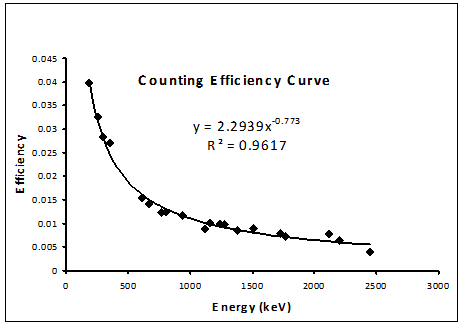 | Figure 2(a). Efficiency curve for liquid matrix |
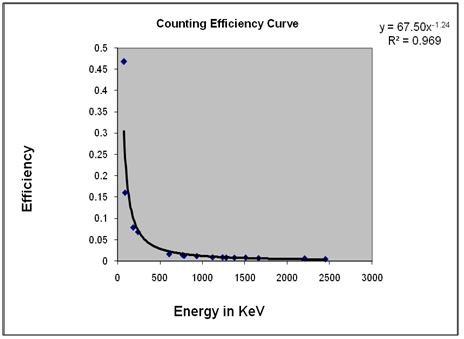 | Figure 2(b). Efficiency curve for solid matrix |
2.5. Activity Concentrations of Coal, Soil and Water Samples
The radionuclide contents and their activity levels of the each sample were measured using a calibrated HPGe detector of energy resolution of 2.0 keV at 1.33 MeV of Cobalt-60 for a period of 10,000 s. The activity concentrations (A) of each radionuclide in the sample was determined by using the count per second (cps) after subtracting the background counts from the gross counts for the same counting time under the selected photo peaks, weight of the sample, the photo-peak efficiency and the gamma intensity at a specific energy as[10]: | (1) |
Where, A = Activity concentrations of the sample in Bqkg-1 or BqL-1.cps = The net counts per second= cps for the sample- cps for the background valueE = The counting efficiency of the gamma energyI = Absolute intensity of the gamma ray and W = Net weight of the sample (in kilogram or litre).The errors in the measurements were expressed in terms of standard deviation (±σ), where σ is expressed as[11]:  | (2) |
Where, Ns is the sample counts measured in time Ts, and Nb is the background counts measured in time Tb. The standard deviation ±σ in cps was converted into activity in Bqkg-1 according to equation (1).
2.6. Absorbed Dose Rates
The external outdoor absorbed gamma dose rates due to terrestrial gamma rays from the nuclides Ra-226, Th-232 and K-40 at 1m above the ground level were calculated as[1]: | (3) |
where, ARa, ATh and AK are the specific activities of Ra-226, Th-232 and K-40, respectively in Bqkg-1.
2.7. Outdoor Annual Effective Dose
The absorbed dose rate was converted into annual effective dose equivalent by using a conversion factor of 0.7 SvGy-1 recommended by the UNSCEAR 2000 and 0.2 for the outdoor occupancy factor by considering that the people on the average, spent 20% of their time in outdoors[12]. The effective dose due to natural activity in the soil and coal samples was calculated by: | (4) |
2.8. Radium Equivalent Activity
The radionuclides Ra-226, Th-232 and K-40 are not homogeneously distributed in coal and soil. The inhomogeneous distribution from naturally occurring radionuclides is due to disequilibrium between Ra-226 and its decay products. For uniformity in exposure estimates, the radionuclide concentrations are defined in terms of ‘Radium equivalent activity’ (Raeq) in Bqkg-1. This allows comparison of the specific activity of materials containing different amounts of Ra-226, Th-232 and K-40 according to Beretka and Mathew[13] as follows: | (5) |
where, ARa, ATh and AK are the specific activities of Ra-226, Th-232 and K-40, respectively in Bqkg-1.
2.9. External Hazard Index
The external hazard index (Hex) is the indoor radiation dose rate due to the external exposure to gamma radiation in construction materials of dwelling which was calculated by[14] . | (6) |
Where, ARa, ATh and AK have the same meanings as in equation (3), and (5).
3. Results and Discussions
The results of the present study on the three types of samples are summarized in following sections.
3.1. Activity Concentrations in Coal Samples
Activity concentrations for Ra-226, Th-232 and K-40 radionuclides in coal samples were determined by equation (1) and the results for the same are shown in Table 1 with the uncertainty level of ±σ. The results for the radionuclides (Ra-22, Th-232 and K-40) are also shown independently in Figur 3, Figur 4 and Figure 5, respectively.
3.1.1. Activity Concentration of Ra-226
In coal samples, the activity concentrations of Ra-226 were found in the range of 3.61±4.44 to 10.46±3.45 Bqkg-1, with an average value of 6.21±3.68 Bqkg-1. The result found in the present study was less than the worldwide average value of 35 Bqkg-1[1].
3.1.2. Activity Concentration of Th-232
The activity concentrations of Th-232 were found in the range of 4.87±5.97 to 16.71±6.24 Bqkg-1, with an average value of 10.69±7.5 Bq-1kg. The result found in the present study was less the world average value of 30 Bqkg-1[1].
3.1.3. Activity Concentration of K-40
The activity concentrations of K-40 were in the range of 127.41±112.56 to 244.10±165.16 Bqkg-1, with an average value of 185.76±138.86 Bqkg-1. The result found in the present study was less than the worldwide average value of 400 Bqkg-1 (UNSCEAR 2000)[1].Table 1. Activity Concentration in Bqkg-1 in Different Coal Samples
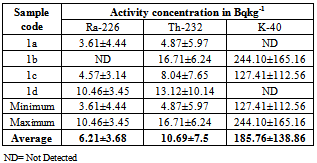 |
| |
|
3.2. Activity Concentrations of Active Soil Samples
Activity concentrations for Ra-226, Th-232 and K-40 nuclides in active soil samples were determined by equation (1) and the results for the same are shown in Table 2 with the uncertainty level of ±σ.
3.2.1. Activity Concentration of Ra-226
In active soil samples, the activity concentrations of Ra-226 were found in the range of 15.88±2.45 to 29.56±2.65 Bqkg-1, with an average value of 23.54±2.6 Bqkg-1. This value was less than the worldwide average value of 35 Bqkg-1[1].
3.2.2. Activity Concentration of Th-232
The activity concentration of Th-232 was found in the range of 42.85±6.32 to 76.93±7.23 Bqkg-1, with an average value of 52.10±4.73 Bqkg-1. This value was higher than that of world average value of 30 Bqkg-1[1].Table 2. Activity Concentration (Bqkg-1) in Different Active Soil Samples
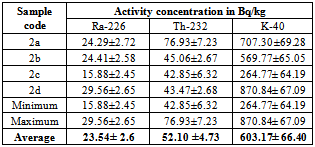 |
| |
|
3.2.3. Activity Concentration of K-40
The activity concentrations of K-40 were in the range of 264.77±64.19 to 870.84±67.09 Bqkg-1, with an average value of 603.17±66.40 Bqkg-1. This value was significantly higher than that of the worldwide average value of 400 Bqkg-1[1].
3.3. Activity Concentrations in Passive Soil Samples
Activity concentrations for radionuclides Ra-226, Th-232 and K-40 in passive soil samples were determined by equation (1) and the results for the same are shown in Table 3 with the uncertainty level of ±σ.Table 3. Activity Concentration (Bqkg-1) in Different Passive Soil Samples
 |
| |
|
3.3.1. Activity Concentration of Ra-226
In passive soil samples, the activity concentrations of Ra-226 were found in the range of 31.54±3.20 to 43.00±3.72 Bqkg-1, with an average value of 36.75±6.75 Bqkg-1 which was comparable to the worldwide average value of 35 Bqkg-1[1].
3.3.2. Activity Concentration of Th-232
The activity concentration of Th-232 was found in the range of 56.01±3.29 to 105.53±9.26 Bqkg-1, with an average value of 76.79±5.53 Bqkg-1 which was also significantly higher than the world average of 30 Bqkg-1[1].
3.3.3. Activity Concentration of K-40
The activity concentrations of K-40 were found in the range of 535.85±79.82 to 680.38±91.28 Bqkg-1, with an average value of 607.18±83.50 Bqkg-1 which was again significantly higher than the worldwide average value of 400 Bqkg-1[1].
3.4. Activity Concentration in Water Samples
The radionuclides in almost all the water samples were below the detection limit. Radionuclides were detected only in two samples (one surface water and one tube-well water sample) and the detected radionuclides were Bi-214 and Pb-212. The activity concentrations of Bi-214 and Pb-212 were 0.37 BqL-1 and 0.97 BqL-1, respectively. Therefore, the activity contents of the water samples collected from the surrounding areas of the coal mine did not show any evidence of enhancement due to the mining activities.
3.5. Radiological Indices
In order to assess the health effects, the radiation hazards such as absorbed dose rate (D), outdoor annual effective dose (E), radium equivalent activity (Raeq) and external hazard index (Hex) have been calculated from the activity concentrations of Ra-226, Th-232 and K-40 using the equation (3), (4), (5) and (6), respectively and the values are shown in Table 4.Table 4. Absorbed dose rate (D), outdoor annual effective dose (E), radium equivalent activity (Raeq) and external hazard index (Hex) of the coal and soil samples
 |
| |
|
From Table 4, it is seen that absorbed dose rate due to the terrestrial gamma rays at 1m above the ground were in the range of 4.61 to 20.35 nGyh-1 with an average 12.01 nGyh-1 for coal samples which was found to be less than the world average value of 55 nGyh-1. The absorbed dose rate were 42.26 to 87.39 nGyh-1 with an average value of 67.14 nGyh-1 for active soil, and that of 70.91 to 112.18 nGyh-1 with an average value of 88.86 nGyh-1 for passive soil samples, respectively. Both of these values were higher than the world average value of 55 nGyh-1[1]. | Figure 3. Distribution of Ra-226 in all coal and soil samples |
 | Figure 4. Distribution of Th-232 in all coal and soil samples |
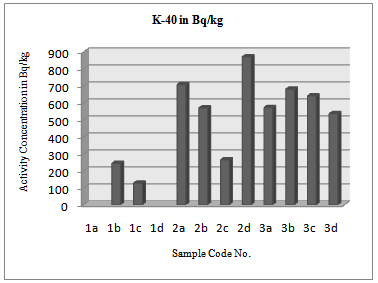 | Figure 5. Distribution of K-40 in all coal and soil samples |
The outdoor annual effective dose for coal samples ranged from 0.01 to 0.2 mSvyr-1 with an average value of 0.015 mSvyr-1. The outdoor annual effective dose was 0.05 to 0.11 mSvyr-1 with an average 0.083 mSvyr-1 for active soil samples and 0.09 to 0.14 mSvyr-1with an average value of 0.11 mSvyr-1 for passive soil samples; which were again less than the world average value of 0.460 mSvyr-1[1].The mean value of radium equivalent activity was 27.07 Bqkg-1 for coal samples, 144.33 Bqkg-1 for active soil samples, and 193.15 Bqkg-1 for passive soil samples. However, all the values obtained here for radium equivalent activity fall far below the limit of 370 Bqkg-1[15]. It is apparent that the radium equivalent activity originating from different regions shows some variations, which are likely to be related to the position of collected coal samples, type of soil, transport process, etc. This is important in selecting suitable coal for burning in the brick fields, soils not only for construction but also for agriculture purposes in order to keep the radiation hazard minimum.The mean value of external radiation hazard index was 0.075 for coal samples, 0.39 for active soil and 0.52 for passive soil samples which all were far less than the unity indicating the non-hazardous category of the samples. The values of hazard indices confirmed that it was safe to carry out the activities in the area for the mine workers, general people and there were no yet significant radiological impact of coal mining on the environment.
4. Conclusions
The radionuclide contents, activity concentrations and radiological impact of the coal, soil and water samples collected from the Barapukuria coal mine of Dinajpur, Bangladesh and its adjacent areas were investigated in the present study. The results indicated that only the natural radionuclides were present in the samples. The natural radioactivity concentrations of Ra-226, Th-232 and K-40 were relatively lower than the world average values in coal samples but were higher in soil samples. The values of mean absorbed dose rate, outdoor annual effective dose and the radium equivalent activity were lower than the global average values; whereas the external hazard indices were found less than unity which indicated that there was no probability of immediate health effect on workers, public due to natural radioactivity present in the samples and the environment under current study adjacent to the mine area was not contaminated due to the mining activities.
ACKNOWLEDGEMENTS
The authors are thankful to Barapukuria Coal Mine Authority for giving the permission to collect the samples, specially Mr. Mir Md. Abdul Hannan, Deputy General Manager (Geology & Hydrogeology) for helping me to collect all the samples with a charming mind. The authors also like thank the technical support staffs of HPRWMU, INST for their help in conducting the study.
References
| [1] | UNSCEAR, Sources and effects of ionizing radiation, Report of the United Nations Scientific Committee on the Effects of Atomic Radiation to the General Assembly, United Nations, New York, USA, (2000). Annex. |
| [2] | Alamgir Miah, M. M. H. Miah, Masud Kamal, M. I. Chowdhury, M. Rahmatullah; Natural Radioactivity and Associated Dose Rates in Soil Samples of Malnichera Tea Garden Sylhet District of Bangladesh, Journal of Nuclear and Particle Physics 2012, 2(6): 147-152, DOI: 10.5923/j.jnpp. 20120206.03. |
| [3] | Rani, A. and Singh, S. Natural radioactivity levels in soil samples from some areas of Himachal Pradesh India using γ-ray spectrometry, Atoms Environ. 39, 6306-1634(2005). |
| [4] | Kannan, V., Rajan, M.P., Lyengar, M.A. and Ramesh, R. Distribution of natural and anthropogenic rodionuelides in soil and beachsand Samples of Kalpakkam (India). Appl. Rodiat. Isot. 57, 109-119 (2002). |
| [5] | Karahan, G. and Bayulken, A Assessment of gamma dose rates around Istanbul (Turkey), J. Environ. Rodioact. 47, 213-211 (2000). |
| [6] | Degerlier, M., Karanhan, G.and Ozger, Radioactivity concentration and dose assessment for soil samples, around Adana, Turkey, J. Environ. Radioact. 99, 1018-1025 (2008). |
| [7] | Pascal Tchokosssa, Thomas B. Makon, Robert Martin Nemba, Assessment of Radioactivity Contents and Associated Risks in Some Soil Used for Agriculture and Building Materials in Cameroon, Journal of Environmental Protection, 2012,3 1571-1578, doi:10.432/jep.2012.311173 published online November 2012 (http://www.SciRP.org/journal/jep). |
| [8] | C.E. Roessier, Z.A. Smith, W.E. Bloch and R.J Prince, Uranium and radium in Floride phosphate materials, Health Phys. vol. 37, 1970, pp. 269-277. |
| [9] | S. Harb, K.S. Din and A. Abbady, Study of efficiency calibrations of HPGe detectors for radioactivity measurement of environmental samples, Proceedings of the 3rd Environmental Physics Conference, 19-23 Feb. 2008, Aswan, Egypt. |
| [10] | M. A. Usif and A. E. Taher, Radiological assessment of Abu-Tartur phosphate, western desert Egypt, Radiation Protection Dosimetry , vol.130, 2008, pp. 228-235. |
| [11] | G. F. Knoll, Radiation Detection and Measurement, Third edn.1998, New York. |
| [12] | K. Debertin and R.G. Helmer.Gammand X-ray spectrometry detectors, North Holland, 1988. |
| [13] | Beretka, J. and Mathew, P.J., Natural radioactivity of Australian buildings, materials, industrial wastes and by products, Health Physic, 48, 87-95 (1985). |
| [14] | Lu, X. And Xiolan, Z. (2006): Measurement of natural radioactivity in sand samples collected from the Booje Weithe sand park, China, Environ. Geol. 50, 977-988. |
| [15] | J. Beretka and P.J. Mathew, Natural Radioactivity of Australian Building Material, Industrial Waste and By-products, Health Physcs, Vol.48, No.1,1985, pp.87-95. doi:10.1097/00004032-198501000-00007. |













 Abstract
Abstract Reference
Reference Full-Text PDF
Full-Text PDF Full-text HTML
Full-text HTML


